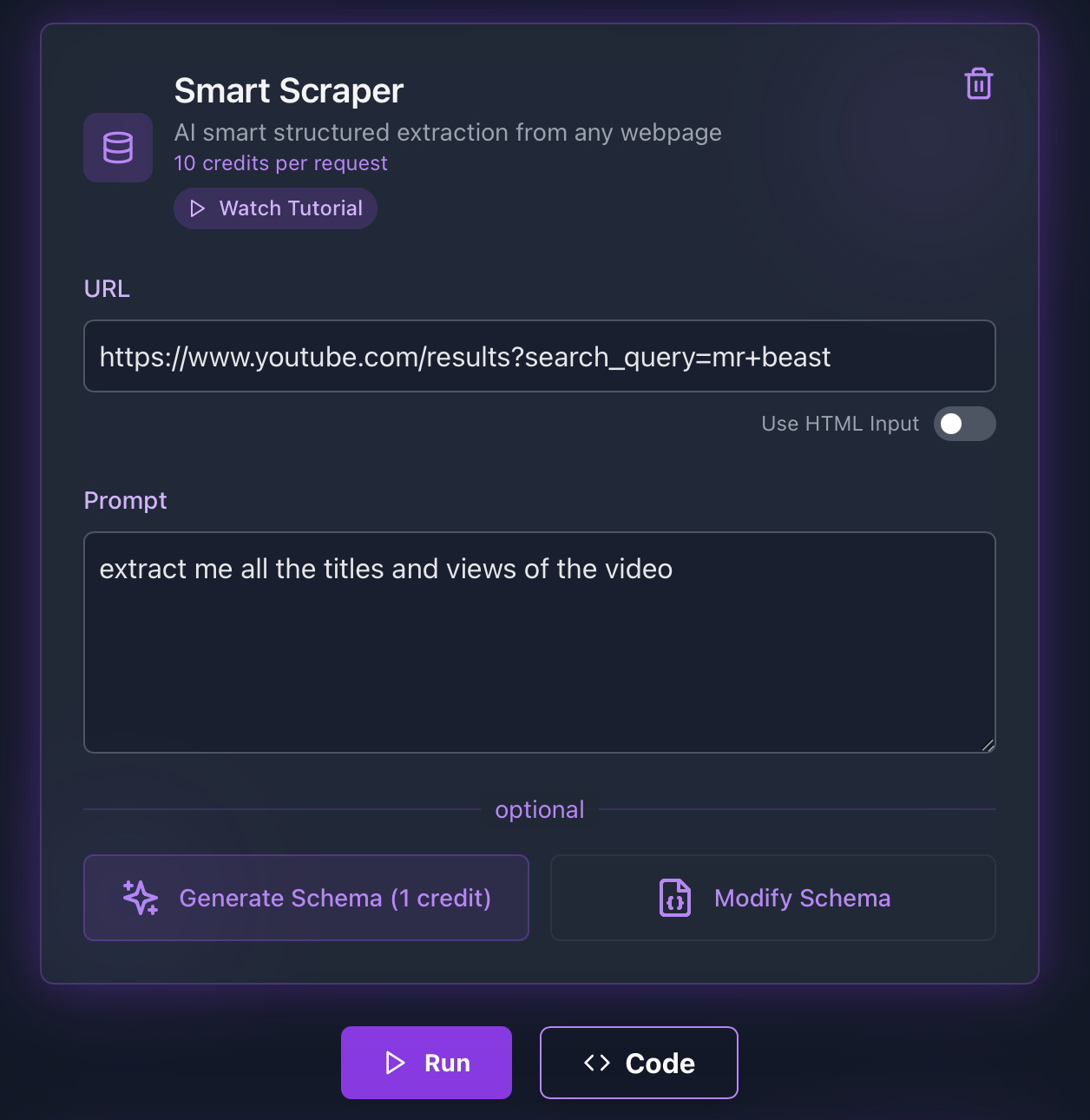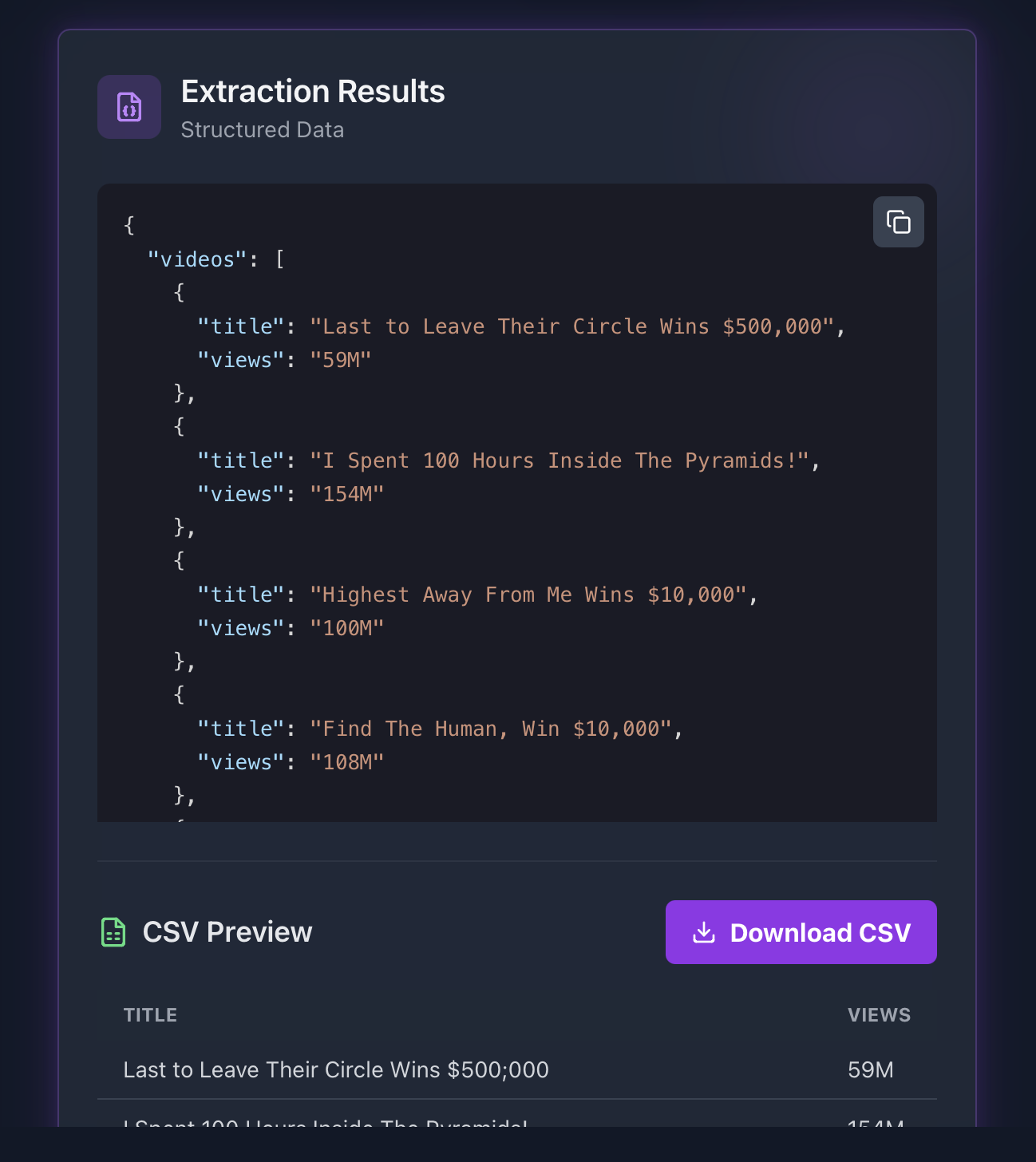使用 ScrapeGraphAI 抓取 YouTube 数据:完整指南

Web Scraping YouTube with ScrapeGraphAI: A Comprehensive Guide
Web scraping is a powerful technique that allows you to extract data from websites automatically. In this guide, we'll focus on scraping YouTube data using ScrapeGraphAI, a robust tool that simplifies extracting valuable information even from complex pages.

What is Web Scraping?
Web scraping involves programmatically accessing web pages and extracting the desired information. It's an invaluable technique for data analysis, trend monitoring, and competitive intelligence. Remember to always scrape ethically and adhere to each website's terms of service.
Why Scrape YouTube?
YouTube is one of the largest video platforms globally, making it a treasure trove of insights:
- Trend Analysis: Discover which videos are gaining traction and what content resonates with audiences.
- Content Optimization: Understand what video titles and formats drive viewer engagement.
- Competitive Intelligence: Analyze competitors' strategies to refine your own content approach.
- Data-Driven Decisions: Leverage real-time data to enhance marketing and content strategies.

Scraping YouTube with ScrapeGraphAI
ScrapeGraphAI streamlines the process of extracting data from YouTube. Below are examples in different programming languages showing how to extract video titles and view counts from YouTube search results:
Python Example
pythonfrom scrapegraph_py import Client from scrapegraph_py.logger import sgai_logger sgai_logger.set_logging(level="INFO") # Initialize the client sgai_client = Client(api_key="sgai-********************") # SmartScraper request response = sgai_client.smartscraper( website_url="https://www.youtube.com/results?search_query=mr+beast", user_prompt="extract me all the titles and views of the video" ) # Print the response print(f"Request ID: {response['request_id']}") print(f"Result: {response['result']}") sgai_client.close()
JavaScript Example
javascriptimport { Client } from 'scrapegraph-js'; import { z } from 'zod'; // Define the schema const videoSchema = z.object({ title: z.string(), views: z.string() }); type VideoSchema = z.infer<typeof videoSchema>; // Initialize the client const sgai_client = new Client("sgai-********************"); try { const response = await sgai_client.smartscraper({ websiteUrl: "https://www.youtube.com/results?search_query=mr+beast", userPrompt: "extract me all the titles and views of the video", outputSchema: videoSchema }); console.log('Request ID:', response.requestId); console.log('Result:', response.result); } catch (error) { console.error(error); } finally { sgai_client.close(); }
cURL Example
bashcurl -X 'POST' \ 'https://api.scrapegraphai.com/v1/smartscraper' \ -H 'accept: application/json' \ -H 'SGAI-APIKEY: sgai-********************' \ -H 'Content-Type: application/json' \ -d '{ "website_url": "https://www.youtube.com/results?search_query=mr+beast", "user_prompt": "extract me all the titles and views of the video", } }'
Example Response
Here's what the extracted data might look like:
json{ "videos": [ { "title": "Last to Leave Their Circle Wins $500,000", "views": "59M" }, { "title": "I Spent 100 Hours Inside The Pyramids!", "views": "154M" }, { "title": "Highest Away From Me Wins $10,000", "views": "100M" }, { "title": "Find The Human, Win $10,000", "views": "108M" }, { "title": "Find This Stranger, Win $10,000", "views": "173M" }, { "title": "Reach the Money, Win $10,000", "views": "127M" }, { "title": "Last Person Hanging Wins $10,000", "views": "188M" }, { "title": "Subscribe For An iPhone", "views": "91M" }, { "title": "Beast Games Winner Breaks Silence on $10,000,000 Prize, MrBeast, and Getting Fired", "views": "132K" }, { "title": "I Survived 50 Hours In A Maximum Security Prison", "views": "273M" }, { "title": "I got pregnant at Beast Games 🤷♀️", "views": "2.5M" }, { "title": "MrBeast Got Arrested !", "views": "18M" }, { "title": "Restocking MrBeast Labs at Walmart", "views": "137M" }, { "title": "MrBeast made fun of me..", "views": "38M" }, { "title": "First Person Who Buys My Chocolate Wins $10,000", "views": "108M" }, { "title": "Pass The Phone To…", "views": "185M" } ] }
Breaking Down the Code
-
Client Initialization and Logging
The client is initialized with an API key, and logging is set to the "INFO" level to track the scraping process. -
Sending the Request
The smartscraper method is used to send a request to YouTube. The request includes a URL targeting YouTube search results for "mr beast" and a custom prompt to extract video titles and view counts. -
Handling the Response
The JSON response includes a list of videos, each with its title and view count, which is printed to the console. -
Closing the Client
Once the operation is complete, the client is closed to free up system resources.
Benefits of Using ScrapeGraphAI
- Ease of Use: Quickly set up scraping tasks with minimal code.
- Customization: Tailor your scraping requests with custom prompts to extract specific data.
- Efficiency: Handle large volumes of data swiftly and reliably.
Frequently Asked Questions
What data can I extract from YouTube?
Extractable data includes:
- Video titles
- View counts
- Channel information
- Comments
- Engagement metrics
- Video details
How do I handle YouTube's terms of service?
Considerations include:
- Rate limiting
- Data usage
- Privacy compliance
- Terms of service
- Ethical guidelines
- Legal requirements
What are the common challenges?
Common challenges include:
- Dynamic content
- Rate limiting
- Anti-bot measures
- Data validation
- Structure changes
- Performance issues
How do I ensure data accuracy?
Accuracy measures:
- Data validation
- Cross-checking
- Error handling
- Quality control
- Monitoring
- Testing
What are the best practices?
Best practices include:
- Rate limiting
- Error handling
- Data validation
- Resource management
- Documentation
- Testing
How do I handle errors?
Error handling includes:
- API errors
- Network issues
- Timeout handling
- Retry mechanisms
- Logging
- Recovery
What about performance?
Performance considerations:
- Resource management
- Caching
- Parallel processing
- Error handling
- Monitoring
- Optimization
How do I scale the solution?
Scaling strategies:
- Resource optimization
- Load balancing
- Error handling
- Monitoring
- Documentation
- Testing
What about data storage?
Storage considerations:
- Database selection
- Data organization
- Backup strategies
- Access control
- Security
- Maintenance
How do I keep the solution updated?
Maintenance includes:
- Regular updates
- Bug fixes
- Feature additions
- Documentation
- Testing
- Optimization
Conclusion
Scraping YouTube data with ScrapeGraphAI enables you to gather valuable insights into video performance and trends, thereby enhancing your content strategy and marketing decisions. By automating data extraction, you can stay ahead in a competitive digital landscape.
Happy scraping!
Did you find this article helpful?
Share it with your network!